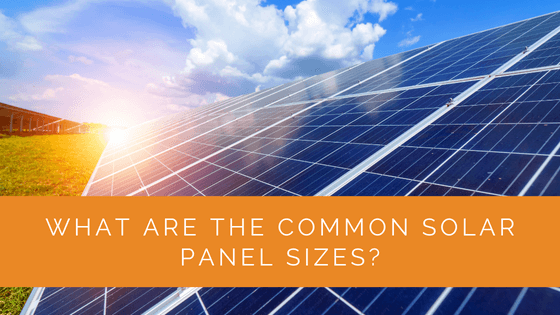The issue of global warming will take years to resolve, and only if people come together to make some eco-conscious and sustainable choices in their lives. One choice revolves around adopting renewable power sources, such as solar energy.
More and more people are coming forward to install residential solar panels on the rooftops of their houses. Now, unless you climb up your roof, it’s hardly likely that you would understand the standard solar panel size or how many pounds per square foot it weighs.
So, before you move forward with solar panel installation, you must know how much these panels weigh and their size.
Let’s walk you through these critical questions to help you make a well-informed decision!
Contents
- 1 Key Takeaways
- 2 What Is the Size of A Solar Panel?
- 3 What Is the Ideal Area for A Solar-Powered Panel?
- 4 What’s the Weight of An Average-Sized Solar Panel?
- 5 What Type of Solar Panel Should You Invest In?
- 6 Is Your Rooftop Strong Enough to Support a Solar Panel Installation?
- 7 What About the Electric Bill?
- 8 Case Study: Implementing Optimal Solar Panel Sizes for Residential Use
- 9 Expert Insights From Our Solar Panel Installers About Common Solar Panel Sizes
- 10 Experience Solar Excellence with Us!
- 11 Final words
Key Takeaways
- Solar panel systems typically come in two configurations: 60 solar cells measuring 66×40 inches and 72 solar cells measuring 78×39 inches, with an average weight of around 40 pounds.
- Residential solar panels are more minor, measuring around 3.25 feet in width and 5.5 feet in length, covering an area of 15 square feet, while commercial panels are larger and heavier.
- The weight and size of your solar panel system should be considered about your rooftop’s capacity to support it, as well as factors like electricity consumption, solar panel system size, and location for calculating potential energy savings and return on investment.
What Is the Size of A Solar Panel?
Solar panel systems come in two variants of configuration:
- The first is a 60 solar cell configuration measuring 25 feet x 5.5. feet or 39-inch x 66 inch
- The second one is a 72 solar cells configuration, which measures 25 feet x 6.42 feet or 39-inch x 77-inch
Both these solar panel systems have a decent thickness of 40 mm.
In simpler terms, if you plan to buy one of the residential solar panels, it must be average-sized at 66×40 inches. The frame of this panel must be no more than 1.25×1.6 inches. These residential solar panels weigh around 40 pounds.
Smaller-sized panels are always the ideal choice to install on the rooftop of your house.
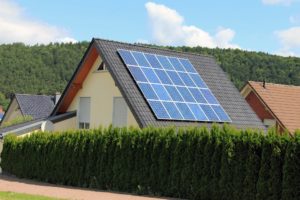
What Is the Ideal Area for A Solar-Powered Panel?
Residential solar panels tend to be smaller, measuring around 3.25 feet in width and 5.5 in length. They easily cover an area of 15 feet.
On the other hand, commercial solar panels are more expansive, easily measuring 6.5 feet in length. These commercial solar power systems also weigh around 50 pounds.
That said, these sizes and weights vary depending on the manufacturer of solar panels. The commercial solar panel will likely produce more power than a residential system.
What’s the Weight of An Average-Sized Solar Panel?
Installation of a rooftop solar system relies on another factor – the weight of the solar panels. Knowing the weight of the solar panel systems will help you decide whether your rooftop can support such an installation.
Each brand of solar panels will differ in weight, but the average weight will fall around 40 pounds nonetheless.
The lightest of all solar panels may weigh around 33 pounds, while the heaviest can take the scale to 50 pounds.
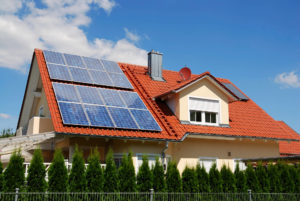
What Type of Solar Panel Should You Invest In?
All solar panels differ in their choice of material – either polycrystalline, monocrystalline, or thin-film. The primary difference between these technologies is the kind of silicon cells they employ.
For clear understanding:
- A polycrystalline solar panel has solar cells which are made of different silicon fragments which are melted together
- A monocrystalline solar panel makes use of only one kind of silicon crystal
This change in the material composition does not necessarily impact the weight and size of the panels, but it does affect the efficiency rate of the panels. The monocrystalline cells are certainly better in efficiency; hence, these cells will be used less in number while producing similar output.
Despite its application, the construction of both commercial and residential solar panels is similar. Each of these panels is made of individual photovoltaic (PV) cells.
These PV cells come in one standard size only, which is 156 mm x 156mm or 6 inches x 6 inches.
The standard residential solar panel is constructed with 60 solar cells, while the commercial solar panels are made of 72 solar cells, which the companies can extend to 98.
Let’s take a quick look at the brief table for an easy understanding of both residential and commercial panels:
| Feature | Commercial solar panels | Residential solar panels |
| Average width (inches) | 39 | 39 |
| Average length (inches) | 78 | 65 |
| Average depth (inches) | 1.5-2 | 1.5-2 |
| Number of solar cells used | 72 | 60 |
Now, if you are wondering, how can a 65 inches x 39 inches cover an entire rooftop?
Consider this: you have a solar panel system of 6 kilowatts. If you install this system with around 20 average-sized panels, your solar panel installation will be about 13 feet (length) and 27 feet (width). Overall, it would take the space of 352 square feet.
In this scenario, we have assumed that all the solar panels are close to each other and there is ample space on your rooftop with no obstruction whatsoever. You might require ample space to accommodate the differently-shaped panel. Plus, you need to ground it at a place that receives maximum sunlight, too!
Do not forget that the solar panel cost depends on your panel system’s distinct design.
If your solar systems, aka all the panels, are compact and have a simple setup, their cost is likely less. If the system is more complex, it will also cost you a hefty price.
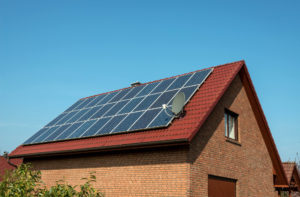
Is Your Rooftop Strong Enough to Support a Solar Panel Installation?
Now that we know a solar panel’s average weight and size, we can easily calculate the weight of the entire panel system. It would help you to determine if your roof can tackle the new panel system with ease or not.
Considering that a solar installation is 6 kilowatts and comprises 20 panels. The panels will likely weigh around 800 pounds if each weighs 40 pounds.
In our above calculations, we assessed that this panel system would be around 352 square feet, weighing 2.3 pounds per square foot (dividing 800 pounds by 352 square feet!).
You would require additional equipment like mounting hardware and solar inverters to help with installation, which will bump the weight to 3-4 pounds per square foot.
Most new roofs can easily hold up to more than 3 pounds per square foot. If you have an old house, though, this roof might not offer the necessary support to the panel system.
In such a case, a roofing company can run a quick roof inspection to help you evaluate if your home can tackle the extra weight of the panel system.
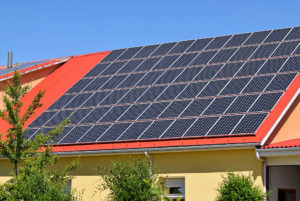
What About the Electric Bill?
Making use of solar energy is both renewable and sustainable. The cost to produce electricity via solar panels is comparatively much less than other options, leading more and more citizens to switch.
If you go solar, you will see a low electric bill and significant financial returns – an extremely low-risk, long-term investment! However, this depends on the following factors:
- Consumption of electricity
- Whether you have chosen a solar lease or purchased your system
- The angle and size of your rooftop
- The size of the solar panel system
- How many hours of direct sunlight does the panel receive?
- The rates of electricity in your area
If you have a 6-kW solar panel system, you will pay around $16,620 for electricity excluding solar tax, incentives, and rebates.
The price is worth it when you compare the energy produced by the panels!
A 6 KW solar panel system can churn out around 750 KW hours monthly. In a year, this will be roughly between 8,000-10,000 KW-hours.
This will inherently depend on where you live, though. If you live in an extremely sunny place like Miami, your solar panel systems will lead to higher energy turnout. Alternatively, the energy production might not be on the higher end if you live in Seattle.
In either case, the energy produced by the 6 KW solar panel system will be more or less sufficient to light up and run your house.
Also, let’s not forget that going solar will enhance your house’s value!
Case Study: Implementing Optimal Solar Panel Sizes for Residential Use
Background
At Solar Panels Network USA, we recently completed a residential solar panel installation project aimed at maximizing energy efficiency while ensuring structural safety. The homeowner was interested in understanding the optimal solar panel sizes for their roof and wanted to make an eco-conscious investment that would provide substantial energy savings.
Project Overview
The goal of this project was to install a solar panel system that would efficiently harness solar energy while fitting seamlessly onto the homeowner’s roof. The project involved selecting the appropriate panel sizes, ensuring structural integrity, and optimizing energy production.
Implementation
The project was carried out in several key phases to ensure a smooth and efficient installation process.
Initial Consultation and Assessment
We started with a comprehensive consultation to understand the homeowner’s energy needs and budget. A thorough assessment of the roof was conducted to evaluate its capacity to support the solar panel system.
Selection of Solar Panels
Based on the assessment, we recommended monocrystalline panels due to their higher efficiency rates. The panels chosen measured 66×40 inches, a standard size for residential installations. This size offered a balance between efficiency and weight, making it ideal for the roof’s structural capacity.
Installation Process
The installation process was meticulously planned to ensure the panels were securely mounted and optimally placed for maximum sunlight exposure. We used a robust mounting and racking system to enhance the stability of the panels.
Energy Storage Solutions
To further enhance the system’s efficiency, we integrated high-capacity solar batteries. These batteries would store excess energy generated during peak sunlight hours, providing a reliable power source during cloudy days and at night.
System Monitoring
Advanced monitoring technology was installed to provide real-time data on energy production and consumption. This allowed the homeowner to track the performance of their solar panel system and make informed decisions about their energy usage.
Results
The implementation of the solar panel system resulted in significant energy savings and improved efficiency.
Increased Energy Production
The high-efficiency monocrystalline panels provided consistent energy production, even during less sunny days, ensuring that the homeowner’s energy needs were met.
Structural Integrity
The robust mounting system ensured that the panels were securely attached to the roof, maintaining structural integrity and preventing any potential damage.
Reliable Energy Storage
The integration of solar batteries provided a reliable backup power source, ensuring uninterrupted energy supply regardless of weather conditions.
Real-Time Monitoring
The monitoring technology allowed the homeowner to optimize their energy usage, leading to further cost savings and improved efficiency.
Summary
This case study highlights the importance of selecting the right solar panel sizes and ensuring structural safety for residential installations. By choosing high-efficiency panels and integrating robust mounting and energy storage solutions, Solar Panels Network USA successfully provided a sustainable and reliable energy solution for the homeowner. Our commitment to quality and innovation ensures that we continue to support homeowners in making eco-conscious investments in renewable energy.
Expert Insights From Our Solar Panel Installers About Common Solar Panel Sizes
Understanding the size and weight of solar panels is crucial for homeowners. Typically, residential panels are smaller and lighter, making them ideal for rooftop installations.
Senior Solar Installer
Choosing the right panel size and type can significantly impact your energy production. Monocrystalline panels, although slightly heavier, offer higher efficiency, which can be a game-changer for residential use.
Lead Solar Technician
Before installing a solar panel system, it’s essential to assess your roof’s capacity. Ensuring that your roof can support the weight of the panels and the mounting system is critical for a successful installation.
Chief Installation Engineer
Experience Solar Excellence with Us!
Trust in Solar Panels Network USA, where our seasoned experts deliver top-quality solar solutions for homes and businesses nationwide. With a legacy of countless successful installations and a commitment to sustainable energy, we’re your reliable partner in the solar journey. Ready for a brighter, eco-friendly future? Call us now at (855) 427-0058 and harness the sun’s power!
Final words
It’s essential to take a quick survey of your rooftop and determine the kind of weight it can handle and the size of panels it can bear.
Newer houses are less likely to face issues installing a solar panel system. Still, the old houses might be unable to handle the weight of an average-sized 6 KW solar power system.
A roofing company can help you in such a case.
Most residential solar panels have 60 solar cells, measure around 3.25 feet x 5.5 feet, and can easily harbor great electricity to run your house.
Before you pick a solar company to buy your new solar panel, ensure you have your budget. Look out for a company that offers a warranty and free home consultation to determine the specifics of your rooftop.
Once installed, your solar home can become one of your most significant assets, and rightly so! So, what are you waiting for?
About the Author
Solar Panels Network USA stands at the forefront of solar energy solutions, driven by a team of seasoned solar engineers and energy consultants. With over decades of experience in delivering high-quality solar installations and maintenance, we are committed to promoting sustainable energy through customer-centric, tailored solutions. Our articles reflect this commitment, crafted collaboratively by experts to provide accurate, up-to-date insights into solar technology, ensuring our readers are well-informed and empowered in their solar energy decisions.

